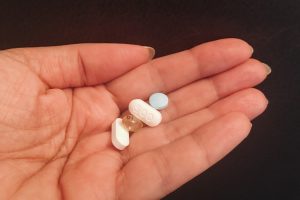Urinary tract infections are one of the most common forms of bladder infections. They cause noticeable discomfort while urinating, often accompanied by a burning sensation and sudden urge to urinate even with an empty bladder, along with other uncommon symptoms. Luckily, there are various treatments out there that can help with this condition, and one of the treatments is nitrofurantoin. This article will highlight everything you need to know about nitrofurantoin dose for UTI in various age groups and medication forms, along with other important information about the medication.
How Does Nitrofurantoin Work?
Despite being in the antibiotic drug class, nitrofurantoin has a unique approach to how it works.
After being absorbed by your gut and into the bloodstream, the treatment is quickly filtered out by your kidneys, where it gets concentrated in acidic urine, thanks to its chemical structure.
Nitrofurantoin then disrupts the bacteria’s DNA, RNA, and cell membrane formation, primarily found in urine, killing them effectively.
As you can see, this mechanism of action and selectivity makes it highly effective in treating UTIs (especially lower tract ones that involve the urethra and bacteria in urine).
Still, it also makes it less effective in treating other infections outside of the urinary tract.
How Many Days Should You Take Nitrofurantoin for UTI?
Like most antibiotics, you’ll need to take nitrofurantoin for a certain number of days to eliminate the bacteria causing the infection.
Ideally, your doctor might prescribe the medication for around 3 to 5 days and up to a week, depending on the severity of the UTI symptoms and other risk factors.
The treatment duration is vital to prevent the infection from recurring, so ensure you don’t take the medication for fewer days than prescribed, even if you have already started feeling better.
Similarly, avoid taking the medication for more days than prescribed to prevent any long-term adverse reactions that might happen.
Nitrofurantoin Dose for Urinary Tract Infections in Adults
Nitrofurantoin comes in various dosage forms, including standard tablets and capsules, slow-release capsules, and liquid.
The nitrofurantoin dosage varies significantly depending on various conditions and whether you’re using the drug for prevention or treatment.
Here’s a quick look at the doses in each case for adults (Also applicable for older teenagers of 12 years old or older):
For Treatment
To treat an existing UTI infection, you can take nitrofurantoin with the following concentrations in various dosage forms:
Standard tablets and capsules: 50 mg taken once every 6 hours.
In severe cases, the dose is prescribed up to 100 mg, taken once every 6 hours. (for 3 to 7 days)
Extended (slow) release capsules: 100 mg taken once every 12 hours in 3 to 7 days.
For Prevention
Nitrofurantoin can also be used as a prophylactic treatment among high-risk patients.
In that case, the dose should be 50 to 100 mg, taken once daily before bedtime.
Nitrofurantoin Dose for UTI in the Elderly
The nitrofurantoin dose for UTIs in the elderly is usually similar to adults, provided that they don’t suffer from renal impairment.
The dose can either be standard tablets or sustained-release ones, and you can also use the medication for treatment and prevention.
However, nitrofurantoin is not recommended for UTIs if significant renal impairment is present.
Usual Nitrofurantoin Dose For Pediatric Urinary Tract Infection
The pediatric dose varies depending on the child’s age and is usually administered as a liquid with 25 mg per 5 ml concentration.
Ideally, nitrofurantoin is not recommended for infants under one month.
For infants and children above 1 month, the treatment is usually determined depending on the particular age and weight of the child.
For Treatment
The usual dose for treatment is 5 to 7 mg for every kg of the child’s mass per day (mg/kg/day), which is usually divided over 4 doses.
For example, a healthy 5-year-old child that weighs around 40 lbs (18 kgs) should take a dose of 22.5 mg to 31.5 mg once every 6 hours per day for 3 to 7 days.
With that being said, the exact dosage is usually determined by the treating doctor depending on the severity of the infection and assessed against the potential risks of the treatment.
For Prevention
The usual dose for prevention is around 1 mg per kg daily, which can be divided over 2 doses per day. The treating doctor also determines this one.
Nitrofurantoin Dose for UTI During Pregnancy
There isn’t enough evidence that proves the safety of nitrofurantoin during pregnancy.
However, a study published in the Canadian Medical Journal raised concern against the use of nitrofurantoin during pregnancy due to its potential adverse effects on babies.
The study found that nitrofurantoin can affect the activity of the glutathione reductase enzyme, which leads to immature erythrocytes, causing hemolytic anemia.

Drug Interactions When Using Nitrofurantoin for UTI
Nitrofurantoin may react with some medications, whether prescribed or over the counter. Among the most popular drugs that interact with nitrofurantoin are:
Probenecid: A popular gout medication that reduces nitrofurantoin concentration in urine, lowering its effectiveness. Also, it increases the concentration of nitrofurantoin in the blood, which raises the risk of side effects due to toxicity.
Methotrexate: An immunity suppressant and chemotherapy treatment that increases the risk of lung-related side effects when combined with nitrofurantoin.
Magnesium Trisilicate: A common antacid that increases pH levels of the stomach and urine, so it decreases the general effectiveness of nitrofurantoin
Sodium picosulfate: A stimulant laxative that loses its effectiveness in the presence of nitrofurantoin.
Nitrofurantoin also interacts with a wide range of medications, so you must consult a pharmacist before taking the drug or combining it with any new treatments.
Nitrofurantoin Overdose Effect when treating UTI
If you exceed the daily dose limit of 400 mg of nitrofurantoin, you’ll suffer from nitrofurantoin toxicity.
The most common symptoms of nitrofurantoin overdose are nausea and vomiting. You might also feel stomach cramps, blurred vision, and pain in your arms and legs.
With that being said, taking an extra dose of nitrofurantoin shouldn’t cause significant harm, but you should still stick to the prescribed dose as much as possible.
What to Do When You Overdose on Nitrofurantoin while Treating UTI
Suppose you take too much nitrofurantoin by accident. It would be best if you didn’t panic, as a slightly higher dose is unlikely to cause serious harm.
However, if you’ve noticed any adverse reactions after taking nitrofurantoin or suspect that you’ve overdosed on nitrofurantoin, you should seek medical attention immediately.
When to See a Doctor?
As previously established, nitrofurantoin is relatively mild regarding short-term side effects, so you don’t have to worry if you only feel mild side effects.
However, if you’ve noticed some severe adverse reactions to the treatment, or your symptoms worsened or didn’t improve within the first 2 to 3 days of treatment, you might need to see your doctor for further assessment and assign a more effective treatment.
Frequently Asked Questions (FAQs)
Nitrofurantoin is effective when it comes to urinary tract infections. According to various reports that study the treatment’s effectiveness, nitrofurantoin has a decent cure rate of up to 94% while presenting fewer side effects than other UTI medications for tract health solutions.
These findings were backed by a large meta-analysis that reviewed all human clinical trials of the treatment from 1946 to 2014, which showed that the treatment has good clinical records and remarkable microbiological efficacy.
Nitrofurantoin is highly effective as an antibiotic for upper and lower urinary tract infections because it targets both gram-positive and gram-negative bacteria.
The treatment also prevents urinary tract infections, especially among susceptible women.
Pharmacodynamic studies and clinical trials also found that the treatment is effective in challenging strains of bacteria, such as E. coli and S. saprophyticus.
The highest effective nitrofurantoin dose is 200 mg per day, usually split over 2 to 4 doses of 100 mg or 50 mg per day, which is generally taken for a prescribed period of 3 to 7 days.
Remember that this dose is mainly for adults, so it’s usually adjusted for the elderly and pediatrics to avoid the toxic effects of nitrofurantoin overdose.
Also, your healthcare provider might adjust the dose depending on your current situation to maximize the efficacy of the treatment.
However, for the success of the treatment, always follow the exact dose prescribed for you.
Nitrofurantoin is effective for urinary infections, especially uncomplicated ones in the lower urinary tract.
This is because the structure of the drug allows it to concentrate in the urine.
Despite its high efficacy as a urinary infection medication, it’s not practical for bacterial infections in other body parts.
Like all medications, nitrofurantoin may cause some side effects that vary in severity, although most people don’t get them. Luckily, the most common side effects are the mildest, which usually include the following:
- Dizziness
- Nausea and vomiting
- Headaches
- Loss of appetite
Other less common side effects include darkening of stool and paleness of urine, yellowing of the eyes and skin (mild jaundice), and fever with headache.
Patients sensitive to any of the treatment’s ingredients (active or inactive) might show signs of allergic reaction.
Nitrofurantoin has a unique chemical structure that allows it to get filtered in the blood and concentrate in urine.
The medication then kills the bacteria causing the infection by infiltrating and damaging their cell membranes.
The treatment is then eliminated through urine along with dead bacteria.
In most cases, UTIs won’t lead to kidney damage or prostate infections in males, especially in mild conditions that are treated promptly.
However, urinary tract infections can still lead to severe complications if they’re not treated immediately.
For example, the proliferation of the bacteria in the urinary tract may cause the infection to spread to other organs, such as the kidney (nephritis) or the prostate gland (prostatitis), known as “secondary infection.”
UTIs with very high fevers in young children may end up causing irreversible kidney damage if you don’t treat it right away.
Nitrofurantoin has a half-life time of around 60 minutes. Since most treatments take about 5 half-lives to be mostly eliminated from your system, regular nitrofurantoin should take about 5 hours to be gone.
All the remaining treatment traces should be out of your system within 3 days.
With that being said, other factors might also impact the rate of elimination of the treatment, such as:
Dosage form: Slow-release macro-crystal capsules might take up to 12 hours to be eliminated completely
Kidney Health: Renal impairment and medications that slow down renal filtration rate cause nitrofurantoin to last longer in the blood.
Final Thoughts
As highlighted, nitrofurantoin is effective when taking this medicine according to the prescribed dose, usually around 50 to 100 mg every 6 hours.
The exact dosage varies depending on your age, the severity of the infection, and whether you’re taking it to treat or prevent UTIs.
Nitrofurantoin is approved by the Food and Drug Administration (FDA) and is available in brand names like Macrobid, Macrodantin, Furadantin, and Aratoin.
Like all drugs, nitrofurantoin may cause some side effects, especially if you’re using it for a long time.
If you notice any severe adverse reactions to the drug, you must tell your healthcare provider immediately.





